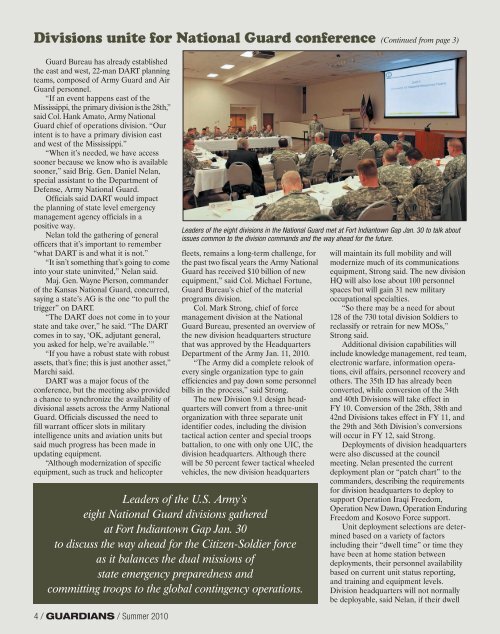Pennsylvania Guardians - Summer 2010
Pennsylvania Guardians - Summer 2010
Pennsylvania Guardians - Summer 2010
You also want an ePaper? Increase the reach of your titles
YUMPU automatically turns print PDFs into web optimized ePapers that Google loves.
Divisions unite for National Guard conference (Continued from page 3)<br />
Guard Bureau has already established<br />
the east and west, 22-man DART planning<br />
teams, composed of Army Guard and Air<br />
Guard personnel.<br />
“If an event happens east of the<br />
Mississippi, the primary division is the 28th,”<br />
said Col. Hank Amato, Army National<br />
Guard chief of operations division. “Our<br />
intent is to have a primary division east<br />
and west of the Mississippi.”<br />
“When it’s needed, we have access<br />
sooner because we know who is available<br />
sooner,” said Brig. Gen. Daniel Nelan,<br />
special assistant to the Department of<br />
Defense, Army National Guard.<br />
Officials said DART would impact<br />
the planning of state level emergency<br />
management agency officials in a<br />
positive way.<br />
Nelan told the gathering of general<br />
officers that it’s important to remember<br />
“what DART is and what it is not.”<br />
“It isn’t something that’s going to come<br />
into your state uninvited,” Nelan said.<br />
Maj. Gen. Wayne Pierson, commander<br />
of the Kansas National Guard, concurred,<br />
saying a state’s AG is the one “to pull the<br />
trigger” on DART.<br />
“The DART does not come in to your<br />
state and take over,” he said. “The DART<br />
comes in to say, ‘OK, adjutant general,<br />
you asked for help, we’re available.’”<br />
“If you have a robust state with robust<br />
assets, that’s fine; this is just another asset,”<br />
Marchi said.<br />
DART was a major focus of the<br />
conference, but the meeting also provided<br />
a chance to synchronize the availability of<br />
divisional assets across the Army National<br />
Guard. Officials discussed the need to<br />
fill warrant officer slots in military<br />
intelligence units and aviation units but<br />
said much progress has been made in<br />
updating equipment.<br />
“Although modernization of specific<br />
equipment, such as truck and helicopter<br />
4 / GUARDIANS / <strong>Summer</strong> <strong>2010</strong><br />
Leaders of the eight divisions in the National Guard met at Fort Indiantown Gap Jan. 30 to talk about<br />
issues common to the division commands and the way ahead for the future.<br />
fleets, remains a long-term challenge, for<br />
the past two fiscal years the Army National<br />
Guard has received $10 billion of new<br />
equipment,” said Col. Michael Fortune,<br />
Guard Bureau’s chief of the material<br />
programs division.<br />
Col. Mark Strong, chief of force<br />
management division at the National<br />
Guard Bureau, presented an overview of<br />
the new division headquarters structure<br />
that was approved by the Headquarters<br />
Department of the Army Jan. 11, <strong>2010</strong>.<br />
“The Army did a complete relook of<br />
every single organization type to gain<br />
efficiencies and pay down some personnel<br />
bills in the process,” said Strong.<br />
The new Division 9.1 design headquarters<br />
will convert from a three-unit<br />
organization with three separate unit<br />
identifier codes, including the division<br />
tactical action center and special troops<br />
battalion, to one with only one UIC, the<br />
division headquarters. Although there<br />
will be 50 percent fewer tactical wheeled<br />
vehicles, the new division headquarters<br />
Leaders of the U.S. Army’s<br />
eight National Guard divisions gathered<br />
at Fort Indiantown Gap Jan. 30<br />
to discuss the way ahead for the Citizen-Soldier force<br />
as it balances the dual missions of<br />
state emergency preparedness and<br />
committing troops to the global contingency operations.<br />
will maintain its full mobility and will<br />
modernize much of its communications<br />
equipment, Strong said. The new division<br />
HQ will also lose about 100 personnel<br />
spaces but will gain 31 new military<br />
occupational specialties.<br />
“So there may be a need for about<br />
128 of the 730 total division Soldiers to<br />
reclassify or retrain for new MOSs,”<br />
Strong said.<br />
Additional division capabilities will<br />
include knowledge management, red team,<br />
electronic warfare, information operations,<br />
civil affairs, personnel recovery and<br />
others. The 35th ID has already been<br />
converted, while conversion of the 34th<br />
and 40th Divisions will take effect in<br />
FY 10. Conversion of the 28th, 38th and<br />
42nd Divisions takes effect in FY 11, and<br />
the 29th and 36th Division’s conversions<br />
will occur in FY 12, said Strong.<br />
Deployments of division headquarters<br />
were also discussed at the council<br />
meeting. Nelan presented the current<br />
deployment plan or “patch chart” to the<br />
commanders, describing the requirements<br />
for division headquarters to deploy to<br />
support Operation Iraqi Freedom,<br />
Operation New Dawn, Operation Enduring<br />
Freedom and Kosovo Force support.<br />
Unit deployment selections are determined<br />
based on a variety of factors<br />
including their “dwell time” or time they<br />
have been at home station between<br />
deployments, their personnel availability<br />
based on current unit status reporting,<br />
and training and equipment levels.<br />
Division headquarters will not normally<br />
be deployable, said Nelan, if their dwell

















